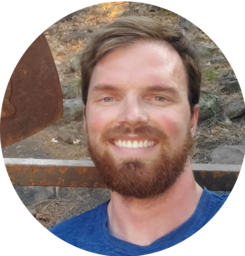
An Intern's Story: From HPC to UAV
Story originially published by NASA.
I knocked on the open door of room 304A at the College of William & Mary's Hugh Jones Hall and walked into the office of Tom Crockett, senior research associate and manager of High Performance Computing, or HPC.
“Are you Mike?” he asked.
“Yes," I said. "Are you Tom?”
“Yes," he said. "Welcome. Here, let’s go get Mike.”
I backed out of Crockett's office and he followed. He made a right and knocked on another open door. “Hey Mike,” I looked up and began to respond when Crockett cut me off, “Mike Pozulp, the student, is here for his interview.” Crockett was not talking to me, but rather to Mike Tighe, the systems engineer of HPC. I followed Tighe and Crockett down the hallway. Crockett stopped at one more open door, that of George Ruddy, the applications analyst of HPC.
The four of us arrived at the conference room. Crockett offered me a seat, which I graciously accepted. It was not until Crockett, Tighe and Ruddy took their seats, all in a row, all on the other side of the conference table, that I realized what was happening. This was going to be a panel interview.
At first, no one spoke. My leg started bouncing under the table. I attempted a smile. It came out like an awkward grin. Crockett, with my resume in front of him, spoke first. “Mike comes to us with good qualifications. Mike, can you take a minute to speak to them?”
“I, uh… um.” What could I say? I had taken a few computer science classes, and noted such on the resume I had submitted, but nothing else felt significant. HPC is a highly specialized subset of computer science to which I had absolutely no prior exposure. Finally, after several agonizing seconds, I found my voice.
“When I was much younger, I played around with HTML while designing part of a website. My senior year of high school I did well in Advanced Placement Computer Science, which got me credit for college-level intro computer science. I’m enrolled in Software Development and Database Systems. I have taken Data Structures and Discrete Math.”
Appearing neither satisfied nor dissatisfied, Crockett continued.
“What about HPC interests you?”
Tough question. I didn’t even know what HPC was. I remembered what the acronym stood for because I looked it up prior to the interview, but I couldn’t say anything else about it.
“I like the hardware, the software, telecommunications, and the whole concept of computing,” I responded. A few books that I referenced in my cover letter came to mind. “I recently read ‘Code: The Hidden Language of Computer Hardware and Software’ by Charles Petzold. It was a really nice and accessible introduction to the underlying concepts of computing – like information theory and number representation – that concluded by walking the reader through the construction of an 8-bit adder. I also enjoyed reading ‘The Information’ by James Gleick, who provides biographical and historical context to contemporary telecommunications and information theory applications.”
At this point I looked up. When I talk, I think, and I tend to forget to look at whomever I’m talking to. Tighe caught my eye and used the opportunity to ask me his first question…
That was February 2012. It was the spring of my freshman year and I was studying computer science at the College of William & Mary in Williamsburg, Virginia. I’m now a rising senior at the college, finished with a computer science major, a minor in mathematics, a minor in economics, and still working for Crockett as the Undergraduate Assistant to High Performance Computing.
Last summer, I interned at NASA Ames Research Center, performing HPC research under the expert direction of Dr. Piyush Mehrotra, chief of the Advanced Supercomputing Division. It was wonderful. I listened to weekly talks on computational fluid dynamics methods. I witnessed beautiful visualizations of wingtip vortices and rotorcraft downwash. I was thrust into a brand new interest: aeronautics.
Last fall, after returning from Ames and beginning my junior year, I started looking around for new sources of aeronautical intrigue. While I didn’t find much at my little, beloved, liberal arts institution, I did get some valuable direction from academic advisors, mentors, and friends. Their consensus was a question: Have you looked at Langley? I had not.
Since January, I’ve been a full-time Langley Aerospace Research Student Scholar, or LARSS, intern at NASA Langley Research Center. I work for Garry Qualls, the eloquent, intelligent, and engaging project manager of a high-profile, two-phase NASA Centennial Challenge with $1.5 million in prize money for professional competitors. NASA Centennial Challenges are purposed with engaging industry and academia to develop technologies that are of interest to NASA. This particular challenge is focused on unpiloted aerial vehicles, or UAVs. The goal is to incentivize the development of UAV capabilities, operations, and protocols in order to aid and inform the integration of UAVs into the National Airspace System for the purpose of commerce.
Which is a long way of saying that I work with UAVs. Specifically, I write the software that runs the competition. Among many other features, the software that I wrote generates missions, scores competitors, maintains range safety and commands our UAV “Traffic Squadron.” In addition to writing software, I can also be found fixing 3D printers, soldering circuit boards, wiring avionics and flight testing our vehicles.
So, as for parting advice, do not fear the academic unknown (HPC), or the intimidating interview (three-on-one panel), just apply and try. The only thing worse than faltering in the face of unimaginable opportunity is missing it entirely.